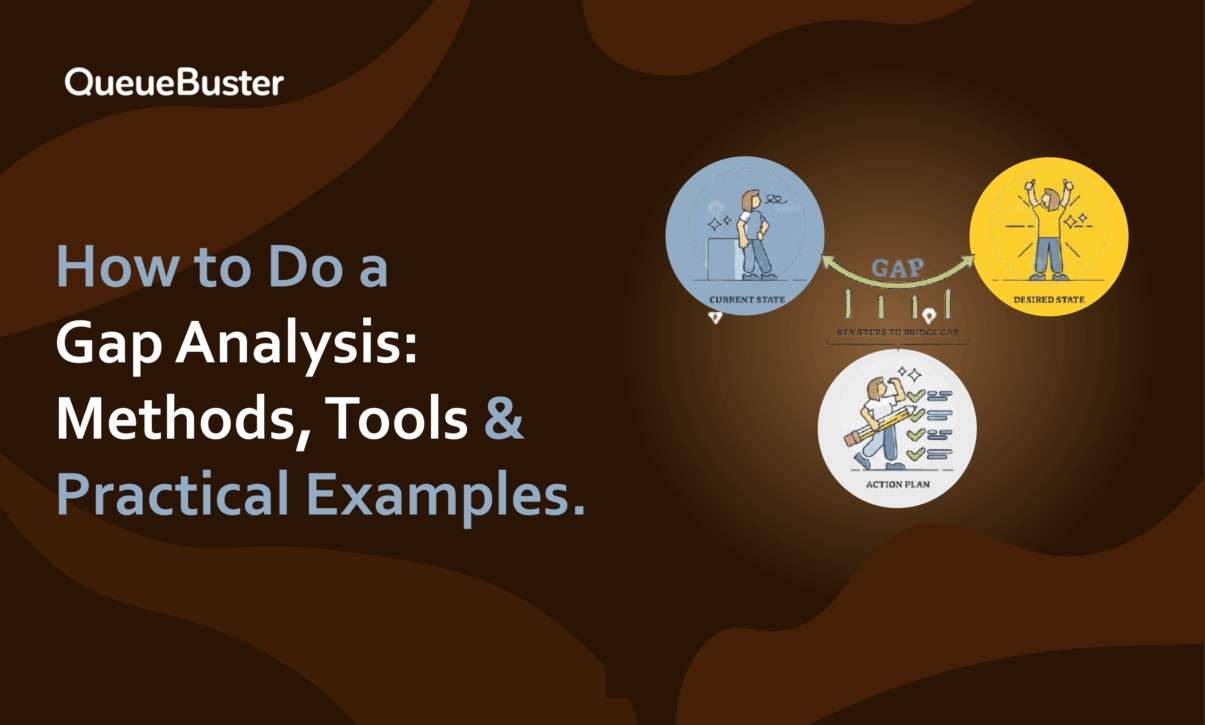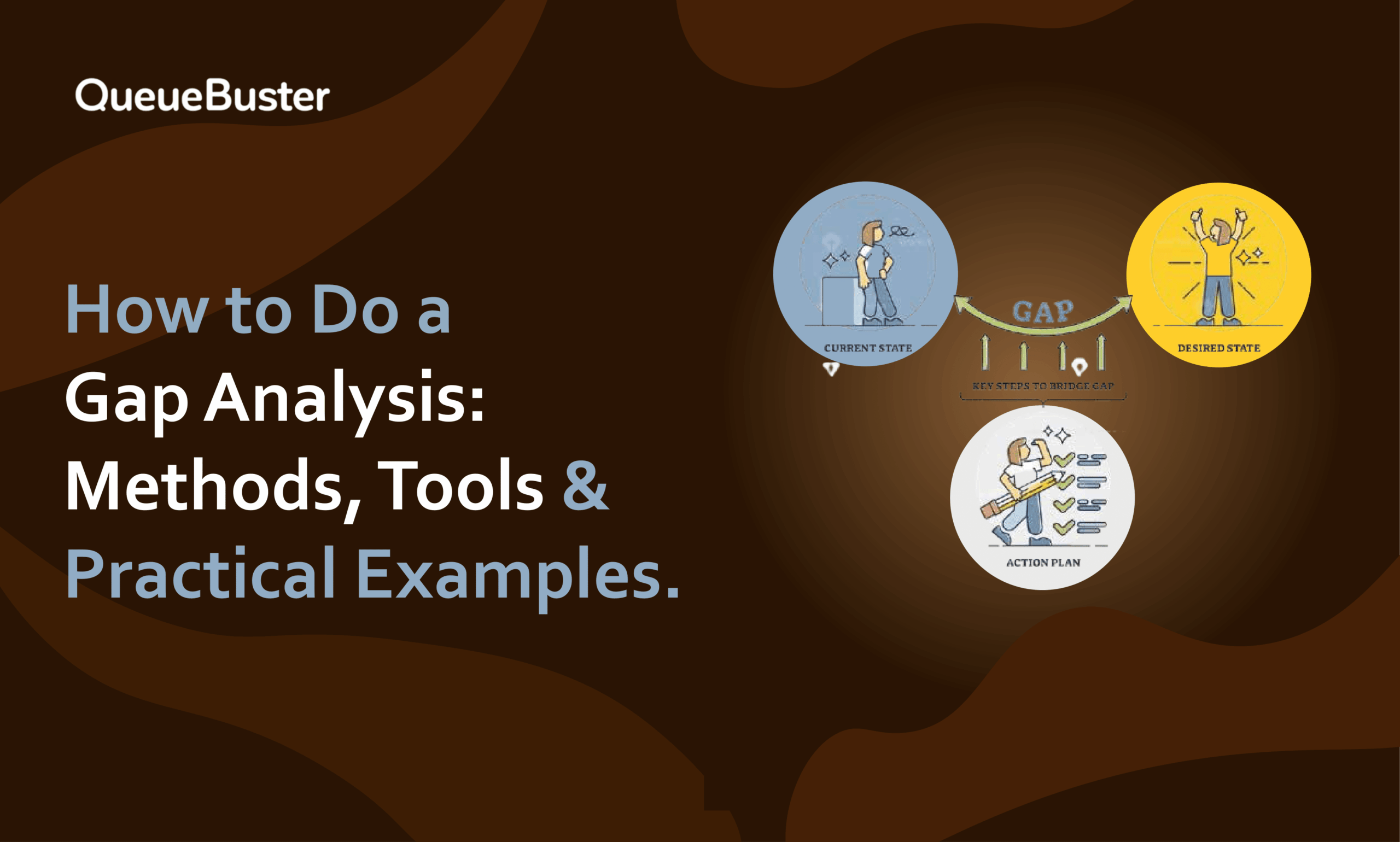
How to Do a Gap Analysis: Methods, Tools, and Practical Examples
How to Do a Gap Analysis: Methods, Tools, and Practical Examples

By Charu Gupta Published: October 30th, 2025
Trying to grow a business without knowing your weaknesses is like sailing a ship without checking for leaks. Everything may look fine on the surface, but inefficiencies, skill gaps, or missed opportunities can quietly slow you down. That’s where gap analysis comes in, an essential tool for businesses to identify where they are, where they want to be, and what’s missing in between.
Whether you’re streamlining operations, using a POS software to track employee performance, or preparing for digital transformation, gap analysis gives you a clear, actionable roadmap to close performance gaps.
In this blog, we’ll break down what gap analysis is, step-by-step methods to conduct it, popular tools, and practical examples you can use in your business today.
What Is Gap Analysis?
Gap analysis is the process of comparing your current performance with your desired goals to identify gaps that need to be addressed.
- Current State: Where your business or process stands today
- Future State: The desired or optimal performance you want to achieve
- Gap: The difference between the two
Think of it as a diagnostic check-up for your business, it highlights exactly where improvements are needed.
Step-by-Step: How to Do a Gap Analysis
Here’s a practical approach to conducting a gap analysis in your business:
1. Define Your Goals and Objectives
Start by being crystal clear about what you want to achieve.
- Example: Increase customer satisfaction score from 75% to 90% in six months
- Example: Reduce product delivery time from 72 hours to 48 hours
Clear goals make it easier to spot gaps between current vs. desired performance.
2. Analyze Your Current State
Collect data about how your business is performing right now.
- Use KPIs, surveys, audits, and reports
- Example: Current average delivery time = 72 hours
- Example: Current customer satisfaction score = 75%
This forms your baseline for comparison.
3. Identify the Gaps
Compare current performance with your set goals.
- Delivery time goal = 48 hours → Gap = 24 hours
- Satisfaction goal = 90% → Gap = 15%
These gaps highlight the areas that need improvement.
4. Determine the Root Causes
Understanding why gaps exist is the most critical step.
- Are processes inefficient?
- Is there a skill or training gap in your team?
- Are you using outdated tools or technology instead of a smart POS solution?
5. Create an Action Plan
Develop strategies to close the gaps.
- Training programs for employees
- New tools/software to automate processes
- Workflow changes to reduce delays
6. Monitor and Review Progress
Gap analysis isn’t a one-time activity. Track your improvements and measure results periodically.
- Use dashboards or KPIs to see if gaps are closing
- Adjust your plan if progress is slower than expected
Methods of Gap Analysis
Different scenarios require different methods. Here are some common gap analysis approaches:
1. SWOT Analysis
- Evaluates Strengths, Weaknesses, Opportunities, and Threats
- Helps identify internal and external gaps
2. McKinsey 7S Framework
- Focuses on Strategy, Structure, Systems, Skills, Style, Staff, Shared Values
- Helps in organizational performance analysis
3. Fishbone (Ishikawa) Diagram
- Used to identify root causes of performance gaps
- Categorizes problems under People, Process, Equipment, and Environment
4. Benchmarking
- Compare your performance against industry leaders
- Helps identify competitive gaps
5. Value Stream Mapping
- Common in manufacturing and operations
- Visualizes the entire process flow to spot inefficiencies
Popular Tools for Gap Analysis
- Excel/Google Sheets: Simple and cost-effective for small businesses
- Project Management Tools: Trello, Asana, or Monday.com for tracking action plans
- Data Visualization Tools: Tableau or Power BI for performance dashboards
- HR & Performance Tools: Keka, Zoho People for employee skill gap tracking
Practical Examples of Gap Analysis
Example 1: E-commerce Order Delivery Gap
Goal: Deliver orders in 48 hours
Current Performance: 72 hours
Gap: 24 hours
Root Cause: Delays in warehouse processing and courier handover
Action Plan: Implement barcode scanning & switch to faster logistics partner
Example 2: Employee Skill Gap in Digital Marketing
Goal: Improve in-house digital marketing campaign ROI by 20%
Current State: Only 10% ROI on campaigns
Gap: 10% ROI difference
Root Cause: Lack of training in SEO and paid ads
Action Plan: Conduct training workshops, use marketing automation tools
Final Thoughts
Gap analysis is not just about identifying problems, it’s about creating actionable strategies to bridge the gap between current and desired performance.
Whether you are trying to boost efficiency, train employees, or stay ahead of competitors, a structured gap analysis and usage of proper technology can save time, money, and missed opportunities.
Start with clear goals, analyze your current state, and act on the gaps, and your business will be on the fast track to growth.
Popular Posts

Why Table Ordering and QR-Based Menus Are Booming in UAE Restaurants
The UAE restaurant industry is evolving faster than ever. From luxury fine […]

5 Effective Tips To Manage Billing For Multiple Customers
Managing billing for multiple customers, especially during peak business hours, can be […]